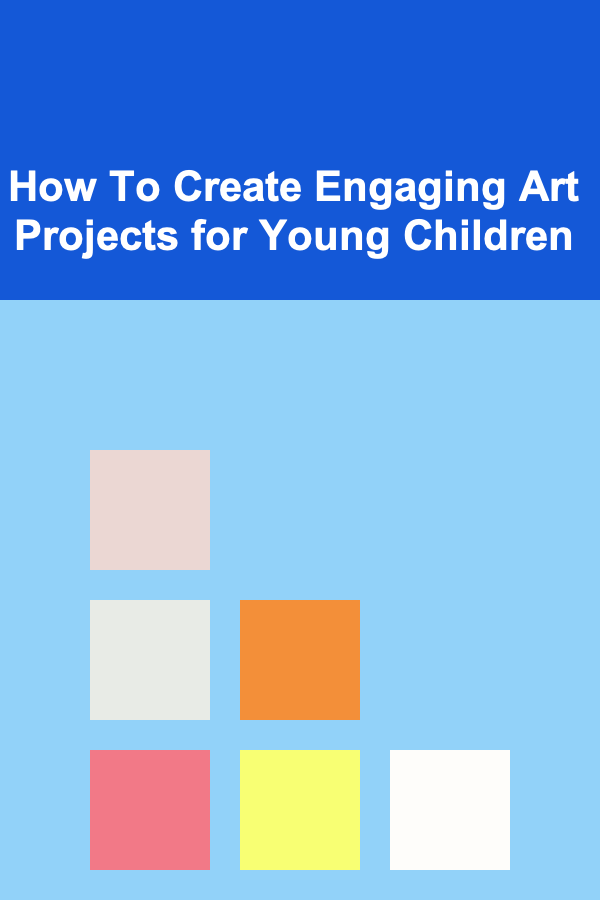
How To Create Engaging Art Projects for Young Children
ebook include PDF & Audio bundle (Micro Guide)
$12.99$9.99
Limited Time Offer! Order within the next:

Art is a fundamental part of children's development. It enhances their creativity, fine motor skills, emotional expression, and cognitive growth. When young children engage in art projects, they not only explore different mediums but also learn valuable lessons about problem-solving, perseverance, and self-expression. The challenge for educators and parents is creating art projects that are both engaging and developmentally appropriate, fostering a love for creativity while nurturing a child's developmental milestones.
This article will explore the importance of art for young children, the developmental benefits it offers, and practical tips on how to create engaging art projects for kids. From choosing the right materials to promoting an environment of exploration and expression, we'll dive into strategies that help make art a fun and enriching experience for young learners.
Why Art Matters for Young Children
Before delving into specific projects, it's essential to understand why art is such a valuable tool for young children. Art is not only about creating a product but also about the process---one that builds several key skills:
1. Creativity and Imagination
Art gives children the freedom to explore their imagination. Whether they're painting a picture, sculpting with clay, or drawing, children get the chance to express their unique thoughts and ideas. This boosts their creativity and encourages them to think outside the box.
2. Fine Motor Skills
Many art projects require children to manipulate small objects, use scissors, paintbrushes, or markers, which helps strengthen their hand-eye coordination and fine motor skills. These skills are crucial for other tasks like writing, dressing, and feeding themselves.
3. Cognitive Development
Art also promotes cognitive development. Through art, children learn about shapes, colors, and textures. They explore concepts like symmetry, patterns, and spatial relationships, all of which lay the groundwork for mathematical thinking and problem-solving.
4. Emotional Expression
Art provides a safe space for children to express their feelings. Whether they're feeling happy, sad, frustrated, or excited, creating something with their hands allows children to process and communicate their emotions. This can be especially beneficial for children who may struggle with verbal expression.
5. Self-Esteem and Confidence
Completing an art project gives children a sense of accomplishment, which boosts their confidence. It also encourages them to take risks and try new things without fear of failure. This ability to experiment and take pride in their work helps them develop a healthy sense of self-esteem.
6. Social Skills
Many art activities can be done in groups, allowing children to collaborate and share ideas. This fosters teamwork and communication, teaching them how to express their thoughts while respecting others' creative processes.
Understanding Developmental Milestones in Art
To design art projects that are appropriate for young children, it's important to consider their developmental stages. Children go through various phases in their ability to create and express themselves through art. These stages can help guide the choice of materials and types of projects that will be most effective at each age.
1. Toddlers (Ages 1-3)
At this stage, toddlers are just beginning to explore their environment and their senses. They may not have the fine motor control to hold a paintbrush or pencil properly, but they can still engage with art in meaningful ways. Activities for toddlers should focus on sensory experiences, such as exploring colors, textures, and shapes.
Key milestones:
- Experimenting with scribbling and making marks.
- Enjoying activities that involve sensory exploration (e.g., finger painting, playdough).
- Beginning to develop hand-eye coordination.
2. Preschoolers (Ages 3-5)
As children approach preschool age, their fine motor skills and cognitive abilities are improving. They can now hold crayons and paintbrushes with more control and may begin to create more structured forms like circles or simple shapes. They are also beginning to understand basic concepts of color mixing, shapes, and patterns.
Key milestones:
- Increased control over tools and materials.
- Beginning to represent objects or scenes (e.g., stick figures, simple houses).
- Showing preference for certain colors or tools.
3. Early Elementary (Ages 5-7)
At this stage, children can create more refined artwork, showing better control over their materials. Their drawings may begin to take on more detail, and they may start following basic artistic techniques. They are also developing a stronger sense of composition and may begin to explore different types of art, such as collage or sculpture.
Key milestones:
- Drawing with more intention and detail (e.g., people with arms and legs, animals with some detail).
- Experimenting with different textures, colors, and materials.
- Understanding basic artistic concepts like symmetry and patterns.
Creating Engaging Art Projects for Young Children
The key to creating engaging art projects is to focus on process over product. Children should feel free to experiment without worrying too much about the final result. Here are some strategies and ideas to make art projects more engaging and beneficial for young children:
1. Provide a Variety of Materials
Young children thrive when they have access to a range of materials that spark their imagination. Be sure to offer a variety of items that can be used in different ways. Here are some materials to include in your art toolkit:
- Crayons, Markers, and Colored Pencils: These are the basics, but encourage the use of different colors and techniques (e.g., shading, cross-hatching).
- Paint: Watercolors, tempera, or finger paints allow children to explore color mixing and texture. Be sure to use non-toxic paints for younger children.
- Clay and Playdough: These allow children to build three-dimensional art and improve their fine motor skills.
- Natural Materials: Twigs, leaves, rocks, and pinecones can inspire nature-themed art projects.
- Recyclable Items: Cardboard boxes, bottle caps, fabric scraps, and other materials can be repurposed for creative projects.
- Textiles and Fabric: Fabric scraps can be used for collage projects or even simple sewing activities that enhance dexterity.
The variety not only enhances the sensory experience but also keeps children engaged, allowing them to experiment with different textures, colors, and techniques.
2. Focus on the Process, Not the Product
One of the most critical elements in creating engaging art projects is to allow children to focus on the creative process rather than the final product. Young children may not yet have the fine motor skills or attention span to create detailed or polished works of art. Instead, their creativity and exploration should be valued over perfection.
Encourage children to:
- Explore different ways of using materials.
- Experiment with color mixing.
- Change their artwork as they go along.
- Enjoy the feeling of creating something without worrying about how it "should" look.
3. Incorporate Sensory Experiences
Young children, especially toddlers and preschoolers, learn best through their senses. Make art projects sensory-rich to enhance engagement. Some ideas include:
- Finger Painting: Let children use their hands to spread paint on large sheets of paper.
- Texture Exploration: Use materials like sandpaper, fabric, or sponges for different textures that children can feel as they create.
- Scented Paints: Mix different scents into your paint (like vanilla, cinnamon, or peppermint) to stimulate the sense of smell during the painting process.
These sensory experiences help children develop their fine motor skills while deepening their understanding of the materials they're using.
4. Use Open-Ended Prompts
Instead of giving children a specific outcome to aim for, provide open-ended prompts that encourage creativity and exploration. For example, instead of asking, "Can you draw a tree?" try asking, "What colors can you use to create a nature scene?" or "How can you make your drawing look different from last time?"
This approach gives children the freedom to interpret the project in their own unique way, which enhances their problem-solving skills and fosters independence.
5. Incorporate Storytelling
Art projects become even more engaging when they are combined with storytelling. This can help children make sense of their creations while adding depth to the process. For example, after painting a picture, you can ask the child to tell a story about what they've created. This encourages verbal communication, imagination, and narrative skills.
Storytelling can also be used as part of the project. For instance, you could read a story about animals, and then encourage children to draw or create animals using materials like clay or paper. The story provides context and inspiration for their artwork.
6. Allow for Exploration and Experimentation
Children should be given time to explore different techniques and make mistakes. A project should never feel like a "test" where they have to get it right. Instead, art should be a safe space for trial and error. Encouraging this mindset fosters a growth mindset, where children are not afraid to try new things and learn from their experiences.
7. Create Art in Nature
Take advantage of the natural world to inspire art projects. Going outside gives children access to new textures, colors, and forms to explore. Some nature-based art ideas include:
- Leaf Printing: Dip leaves in paint and press them onto paper for a textured print.
- Rock Painting: Gather small rocks and paint them with fun designs or characters.
- Nature Collage: Collect items from nature (leaves, sticks, flowers) and create a collage on cardboard.
Nature-based projects not only engage children with their surroundings but also allow them to appreciate the beauty of the environment around them.
Conclusion
Creating engaging art projects for young children involves more than just providing them with crayons and paper. It's about giving them the freedom to explore, express, and experiment with different materials and techniques. By focusing on the process of creation rather than the final product, we can help foster a lifelong love of art in children.
Art supports children's emotional, cognitive, and physical development. It encourages creativity, enhances problem-solving skills, and helps build self-confidence. Whether it's through finger painting, nature-based activities, or storytelling, there are endless ways to make art an exciting and meaningful part of a child's life.
By offering a variety of materials, allowing plenty of time for experimentation, and focusing on the joy of the process, you can help children experience the many benefits of art. With a bit of creativity and a lot of encouragement, every child can become an artist in their own right.
Reading More From Our Other Websites
- [Needle Felting Tip 101] Creative Project Ideas: What to Make With Your New Needle Felting Kit
- [Organization Tip 101] How to Manage Event Logistics for a Seamless Experience
- [Personal Financial Planning 101] How to Save for Your Child's College Education
- [Home Soundproofing 101] How to Soundproof Your Home for a Peaceful Living Environment
- [Home Budget 101] How to Budget for Furniture Replacement & Upgrades
- [Organization Tip 101] How to Make the Most of Limited Closet Space Together
- [Personal Care Tips 101] How to Prevent Over-Exfoliation with a Gentle Facial Scrub
- [Organization Tip 101] How to Add Warmth and Personality to a Scandinavian Living Room
- [Home Security 101] How to Upgrade Your Door Lock Cylinder for Stronger Home Security
- [Simple Life Tip 101] Best No‑Screen Evening Rituals to Unwind and Embrace Simplicity

How to Incorporate Sustainability Practices in Rental Management
Read More
How to Organize Your Hobby Collection for Easy Access
Read More
How to Master Vector Tracing Techniques
Read More
How To Grasp the Concepts of V2L (Vehicle-to-Load)
Read More
Exploring the World of Nutritional Therapy: A Comprehensive Guide
Read More
How to Arrange Dried Flowers for Long-Lasting Beauty
Read MoreOther Products

How to Incorporate Sustainability Practices in Rental Management
Read More
How to Organize Your Hobby Collection for Easy Access
Read More
How to Master Vector Tracing Techniques
Read More
How To Grasp the Concepts of V2L (Vehicle-to-Load)
Read More
Exploring the World of Nutritional Therapy: A Comprehensive Guide
Read More